There is no better way to get an idea of what South Beach is like than flying over it in a small plane. And since there is water everywhere in Miami, the most comfortable thing is that the plane is a seaplane, so we can ride it in the Biscayne bay itself.
I invite you to join me for an aerial tour of what has been the city where I have lived for more than 14 years.
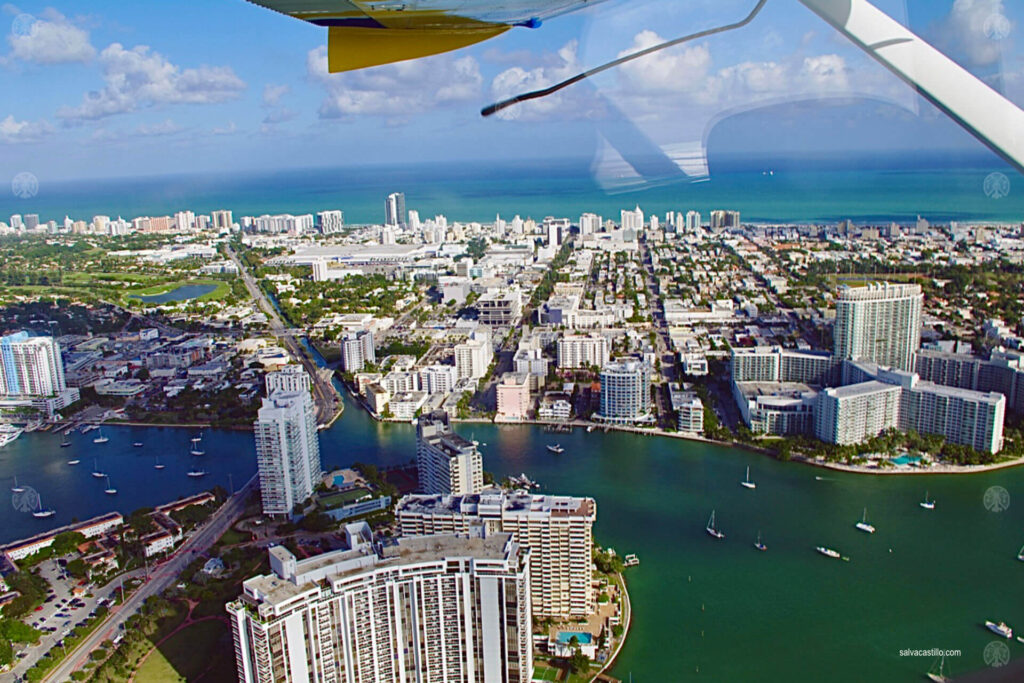
The aircraft was a single-engine plane with water skis that was parked -amerized? 🤔 – on Watson Island, in the middle of Biscayne Bay.
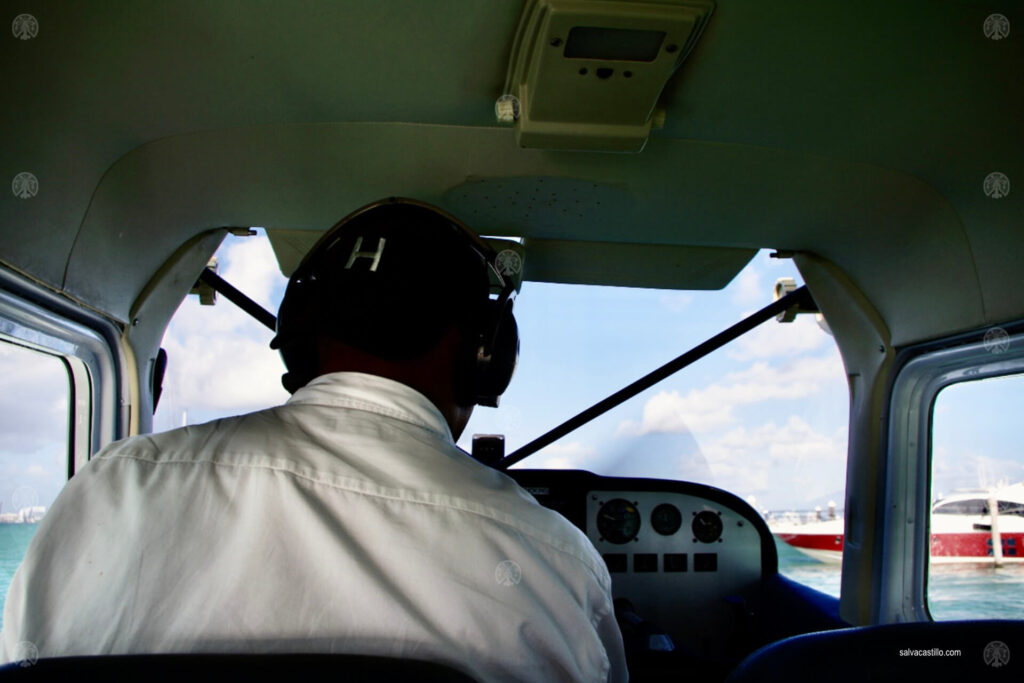
The plane had large windows and allowed a good view of the outside, the city of Miami.

As soon as we took off, we turned right to fly over Fisher Island, the island whose inhabitants have the highest income per capita in the U.S. The island can only be accessed by ferry, private yacht or helicopter. It has a golf course, school, supermarket… and it is also located 200 meters from South Beach, separated only by a channel that allows the entry and exit of cruise ships to the port of Miami. The bridge you see is the MacArthur Causeway that connects with the interstate highway I-395. It is one of only two public bridges with which to enter or exit South Miami Beach. For hurricane evacuation they are always a problem.
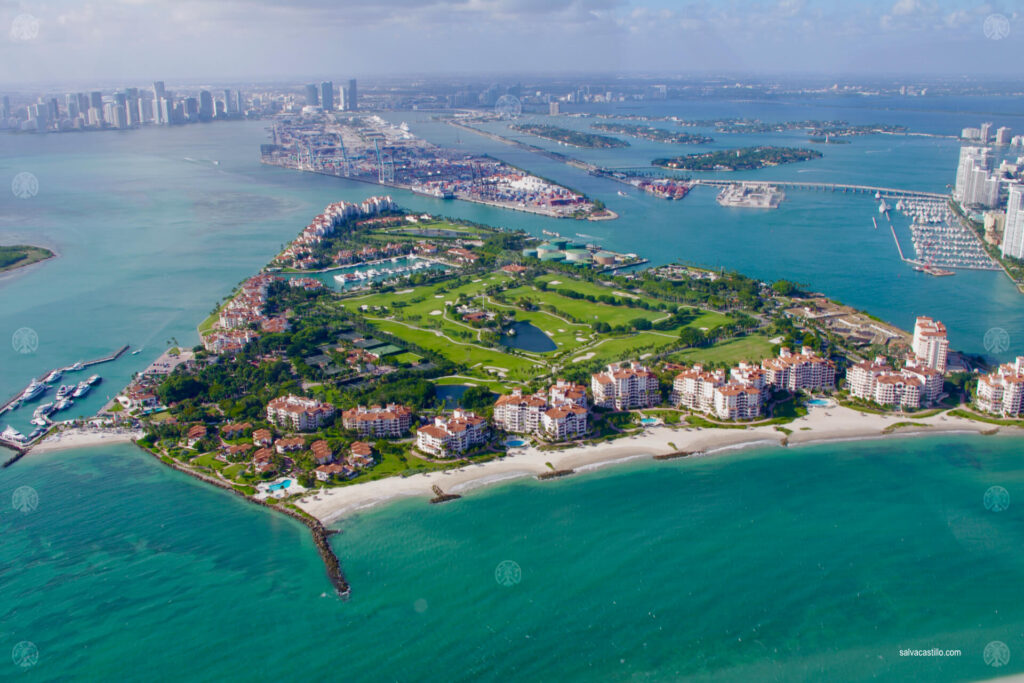
The southern end of South Beach is dominated by several skyscrapers, which preside over the canal and the South Pointe Park built at their feet. The salmon skyscraper is the Portofino tower, which I have always been particularly fond of. On Sunday afternoons several cruise ships depart for their respective destinations. As all the cruises have to leave by the canal, it is common for groups of friends to go to the beach to spend the day and when it’s the time when the Cruise leaves port to go to the park with banners and / or flags to greet and say goodbye to a friend who is leaving on it. Because of the short distance, from the cruise ship you can perfectly distinguish who is who.

This beach area so far south is called South Pointe Beach. It is always crowded because there are parking lots around and there is also the jewel of the lounge in Miami: the Nikki Beach Restaurant and Beach Club. It is a place of high standing where you can spend the whole day uninterruptedly. On the patio in front of the building there are cushioned hammocks where you can lie down and have your favorite cocktails brought to you while a DJ plays chill music. If you prefer a little more intimacy, forming a semicircle around there are several canopied beds where you can enjoy the atmosphere in an even more relaxed and intimate way when you close the curtains. Distributed throughout the garden there are numerous water sprays to refresh the environment, as well as showers and also the beach, to which you have your private access.
Back in the time, we locals guys had already got the hang of it to avoid the queues and enter and exit freely using one side hidden entry. You were on the beach and you felt like listening to some music and having a beer and you just had to walk in. The waiters already knew us and there wasn’t much drama. At night they were stricter because you had to pay an entrance fee to get into one of Miami’s rogue gems: Nikki on a Sunday at 12 AM. At 9 p.m. at Nikki, the only people left were the stinkers who were overextending their Sunday and the clients who were going to the fancy restaurant on the first floor. And the place was quite deserted. But at 11 p.m. on a Sunday night -although Mondays are workdays, you know- there was a long queue to access Nikki’s second floor. A discotheque with psychedelic decoration, dark and with neon all over the place, where the poshest of the posh -I guess enjoying a party after having had dinner at the restaurant- and the postmodernists with outlandish outfits gathered. If you also add the non-locals -who could be either tourists who had been tipped off or Miami regulars: people who, without being residents, visit the city very regularly for pleasure or work- it was a bizarre cocktail of techno and depravity. People were partying like it was their last night on earth. For how chic the restaurant was on the first floor, and how uptight the posh people are in Miami – more concerned with seeing and being seen than dancing and enjoying themselves – the second floor of Nikki Beach was where you had to be in the wee hours of Sunday to early Monday morning. Friday and Saturday I don’t know because I never went. Now it may be something else. Much of that Miami died with the pandemic.

Miami is a city of modern territorial planning. And what they did was to design a land use map where the streets form a grid of perpendicular streets, which is the best way to organize the territory. When a street in Miami goes from north to south, it is called an Avenue. When it goes from east to west, it is called a Street. The street on South Pointe Drive where the skyscrapers are located is 1st street. And so we increase as we pass streets to the north. The famous Española Way is the 14th, and the famous Lincoln Road is the 17th. The first 5 streets of South Miami Beach form the SoFi (South of Fifth) district. Boutique hotels, high-end restaurants, and a set of upscale nightclubs in which they created a leisure bubble to isolate themselves from the rogue crowd of Washington Ave and Ocean Drive, a few streets further north in South Beach itself. They succeeded for some time -they also opened an Amnesia Miami-, although the locals could always find hillbilly redoubts such as Ted’s Hideaway, a weird bar that seemed to be taken from the deep America and that didn’t fit in with the surrounding establishments. Blue Long Island at 4 dollars, 100 meters from Nikki Beach and open until the morning of the next day. Yeah.

Further north, between 9th and 22nd, is the rogue area of South Beach with the most famous clubs and pubs: the Mansion or Cameo nightclubs, the Beach Club Clevelander, or that bizarre and kitsch thing that is Mango’s Tropical Café, where I always took my guests to leave drenched in sweat and laughing like never before. At the beginning of moving to the city I contemplated renting an apartment in that area but then I thought better of it: I would never be able to sleep because of the noise any day of the week -the tourists never stop- or to make any progress in my work, with so many temptations at all hours.
From 23rd St. upward north a more residential area opens up with more apartments and houses and less pubs and discos. On the other side of the island is the Miami Beach municipal golf course and the other way in and out of South Beach, the Julia Tuttle Causeway (Interstate I-195, which becomes 41st St. in Miami Beach). The buildings seen on the right are the Mount Sinai Health Complex.
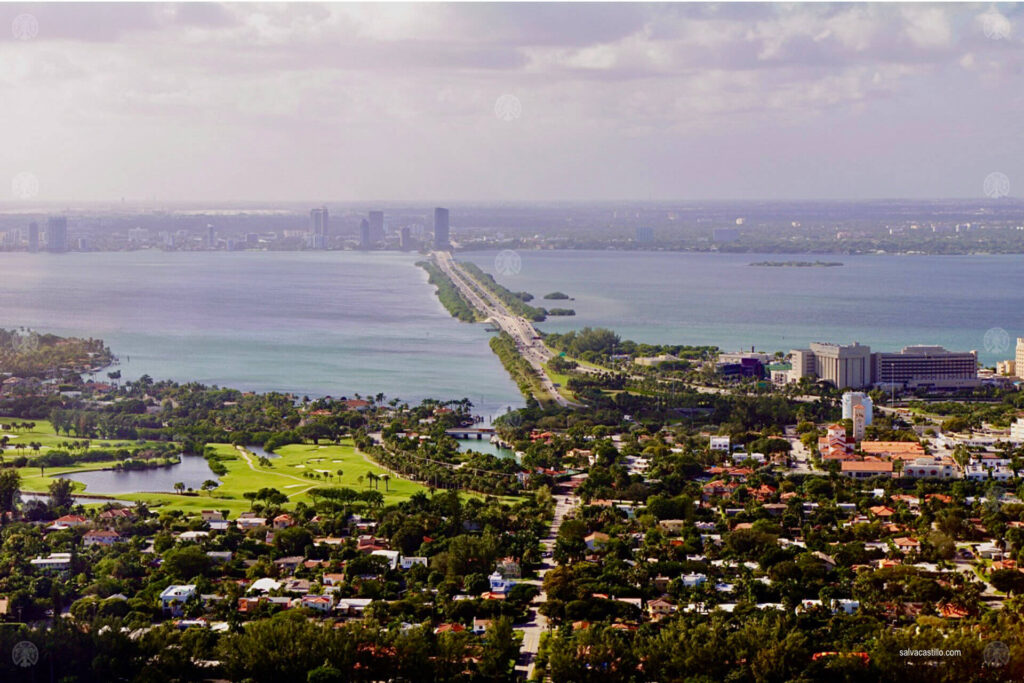
One of the most famous hotels in Miami Beach is the Fontainebleau. It is a massive resort of high standing that has hosted numerous members of the international show business. It has a nightclub, the LIV, very famous in Miami. Strict dress code and drinks at 15 dollars. On Wednesdays, “girls night out”.

A little further north we come across two well-known condominiums: the Green Diamond and the Blue Diamond, so called because of the colored illumination they have in their pyramidal domes, which make them visible from long distances at sea or on land. To the left, and next to the Green Diamond is the Mimosa Condominium, a much older building where several Spanish professors lived in Miami. Some friends of mine lived right in an apartment on the north side of the Mimosa that faced the south side of the Green Diamond, separated by maybe 100 feet one window from the other. An apartment in one or the other condos had very different market values (the Green Diamond being several million dollars). The funny thing is that the 12-story neighbors on the south side of the Green Diamond, having paid the huge amount they had paid for their apartment, lived with the curtains drawn day and night because, having large windows, you could see a-b-s-o-l-u-t-e-l-y e-v-e-r-y-t-h-i-n-g. But hey!, they could say they lived at the Green Diamond in Miami Beach. Do not be so salty!.

I lived for 4 years on Collins Ave. and 54th St. in the Carriage House condo. The building had a small commercial area inside, with a restaurant, convenience store, hairdresser, and real estate manager. I was very lucky to snag it and in that apartment I treasure many of my best moments in Miami.
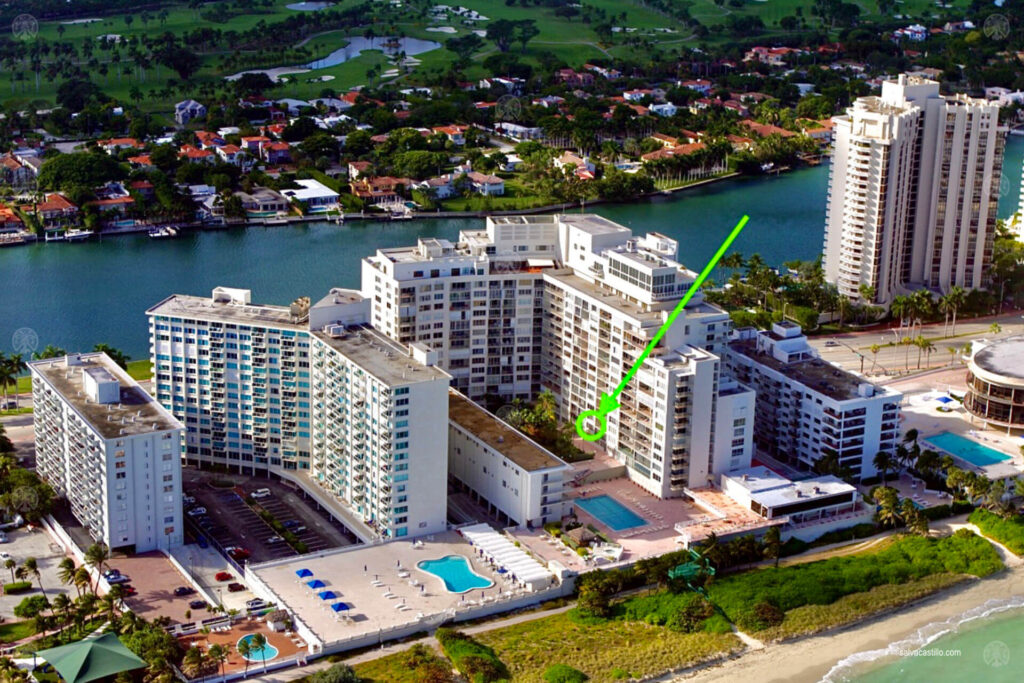
Life as a single guy by the beach and at a 20 minute walk from South Beach certainly had its charms. They were a few years of furious work and continuous business trips to Argentina and Mexico, but I really enjoyed them.

On the other side of the Carriage House was the Intracoastal Waterway that goes up to Normandy and Bal Harbor. Legend has it that Enrique Iglesias went water skiing completely naked late at night to fulfill a bet. Back in the time his father Julio Iglesias bought a small island (Indian Creek) located a couple of kilometers further north.

The Flagler Monument Island is an artificial island with a monolith honoring Henry M. Flagler, a 19th century Miami pioneer who invested in the construction of the East Florida Railroad and co-founded the modern city of Miami. Initially the shape of the island was a concrete circle but nature has now taken possession of the island.
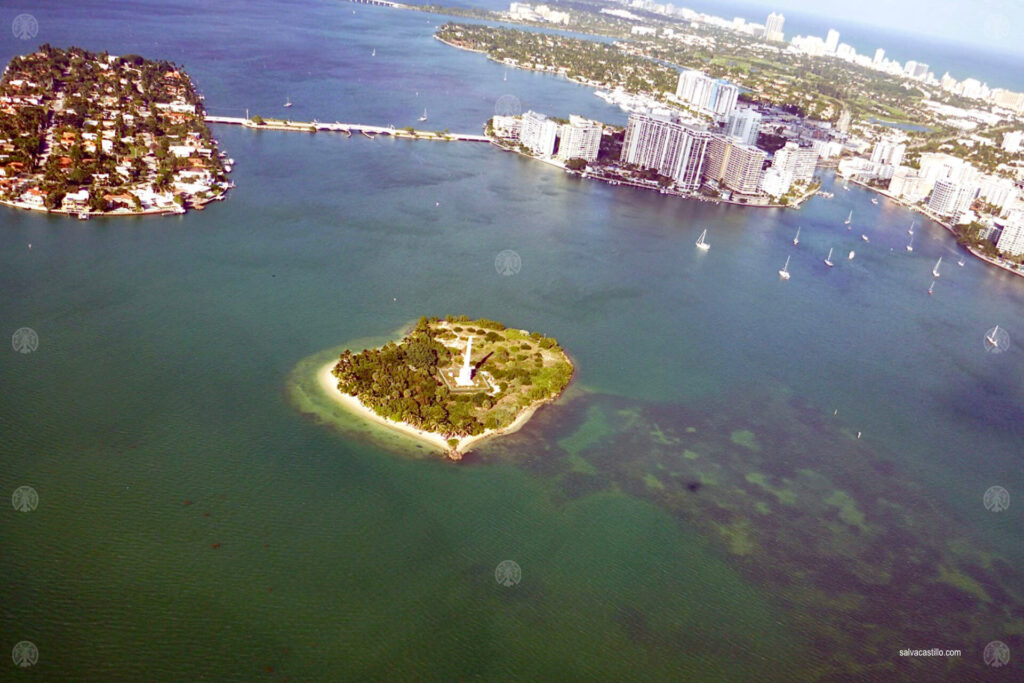
This is the typical Miami sky in winter: a deep blue and a myriad of cumulus clouds in it. As it is unusual for it to rain in winter and with these sunny days, the high season for tourism in Miami is precisely from November to March, which is when Snowbirds tourists travel from their homes in the cold areas of North America (Canada and northern states in the USA) to enjoy the weather in Miami. In summer, the scorching heat and humidity is a difficult mix for the uninitiated to endure, and it often rains – tropical, hot, fierce rains that fall for a short period of time. Add to that the hurricane season is from June to October. It is low season.

Miami is home to many celebrities and billionaires from all over the world who have a residence in the city. They are scattered throughout many areas of the city, but the islands in Biscayne Bay -Star Island, Palm Island and Hibiscus Island-are famous for allowing very good seclusion from the plebs. The bridges that connect the islands are of restricted access, so if you are curious to see “the houses of the celebrities” you have to rent a boat tour that goes sailing through the islands and well, it might satiate your curiosity if you have it.
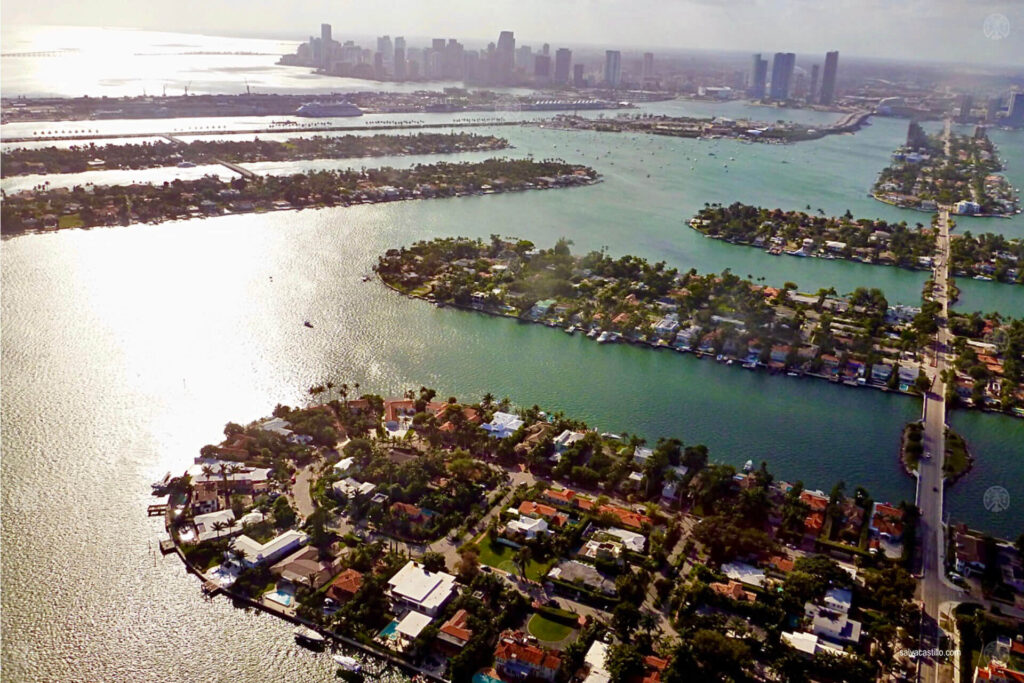
The cruise terminal at the Port of Miami has been increasing in size and infrastructure over time. There are days when there are several huge cruise ships anchored in the port. Travelers come from all over the world to cruise out of the city because it is the best place -along with Ft. Lauderdale and perhaps Orlando- to take a more or less long cruise in the Caribbean Sea. The Bahamas Islands are half a day away.

Water – and yachts – are ever-present in Miami life. Motorboats are very common – it’s like buying a second car in Europe – and many people keep them in the garden of their house mounted on the trailer with which they move them. It is also very common for houses to have direct access to a canal, and boats are simply moored in the water. Many others pay a monthly fee to have the boat stored in a marina where the operators lift it with cranes to structures of various heights to store them. But when your boat is a sailboat and has a mast -and you don’t want to dismantle the mast-, you moor it in the bay and use a water cab service that takes you to and from the boat.
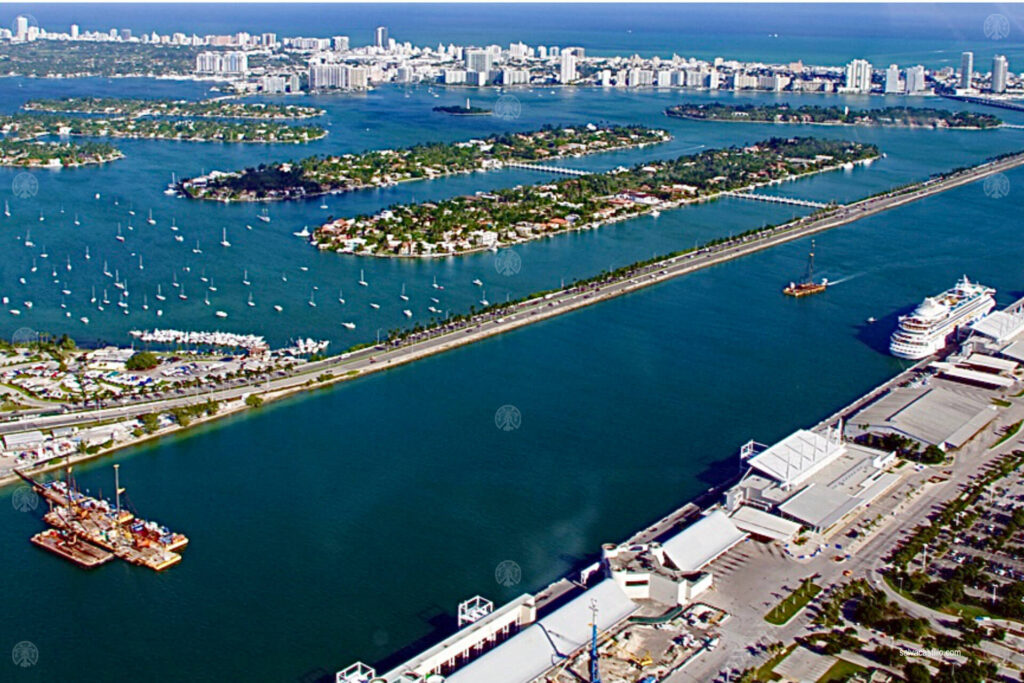
Miami harbor, Fisher Island on the right, and South Beach in the background.

The Matheson Hammock Park has a small atoll-shaped lagoon surrounded by palm trees. It is a very nice place that also at sunset gives some beautiful photos, with the typical pink-reddish sky of Miami – which together with the intense turquoise blue of the water and the neon signs of Ocean Drive in South Beach, the origin of Miami has associated fluorescent colors in the merchandising of the city.
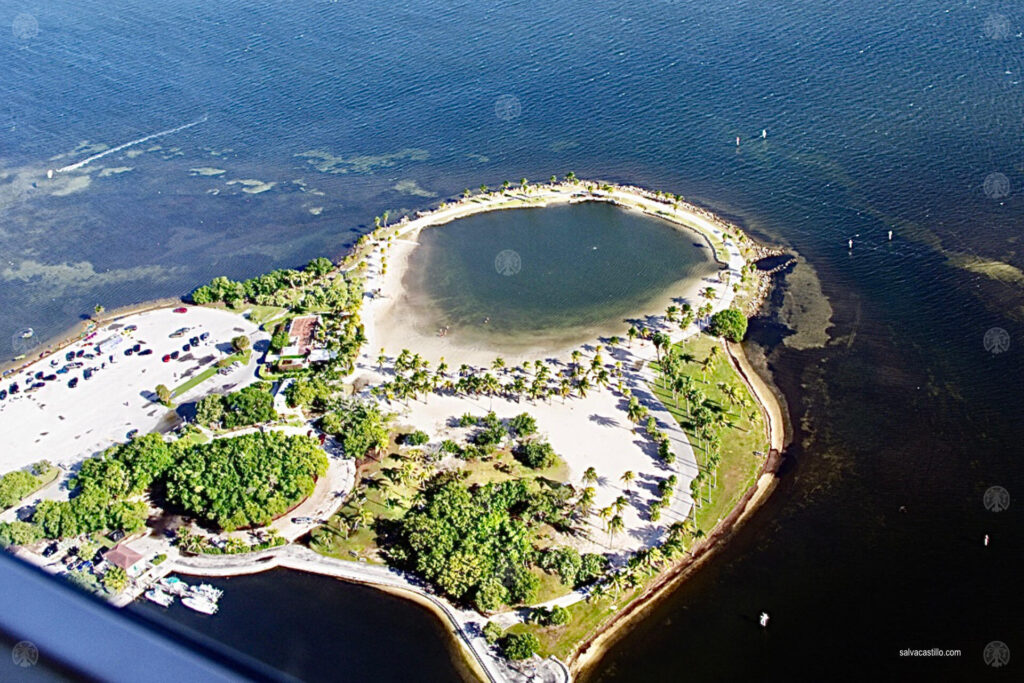
As the entire bay is protected from the strong swell of the Atlantic Ocean by Cayo Vizcaino, it is a great place for kite surfing.

Another posh area of Miami is Coral Gables and Coconut Grove, with its respective marina full of yachts. It is very normal that in any street -if is not a ghetto neighborhood- you will find one or several boats. The hobby is very big.
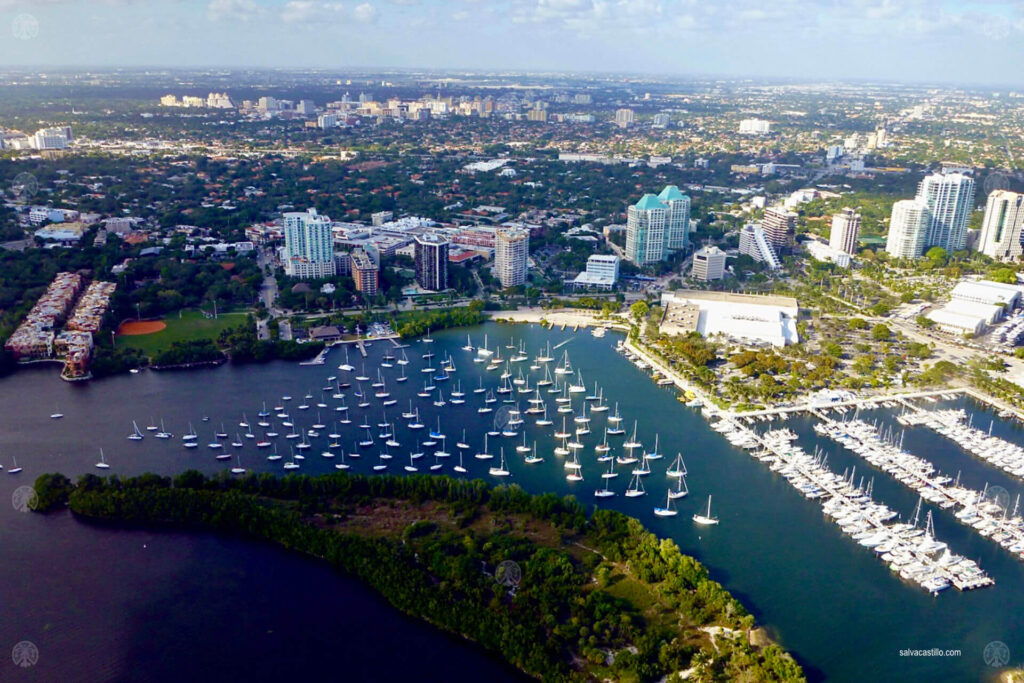
The Miami skyline with the Rickenbacker Causeway in the foreground, which is another road that this time connects Miami with the northern keys (Virginia Key and Key Biscayne). That elevation of the Rickenbacker Causeway is, without exaggeration, the steepest slope of public access that can be found for miles around. It has a bike lane and on weekends is full of cyclists who are itching to make the slope and get to Key Biscayne. It is the Strava point of all Miami.
Miami is an absolutely flat city, with a slope of perhaps 10 meters in all its extension. The other option to find “slopes” are the parking lots, which are either within the structure of the skyscrapers, or have their own building of various heights. One Saturday night I went with friends skateboarding with a long-board in the parking lot of a building of the University of Miami -to avoid traffic.
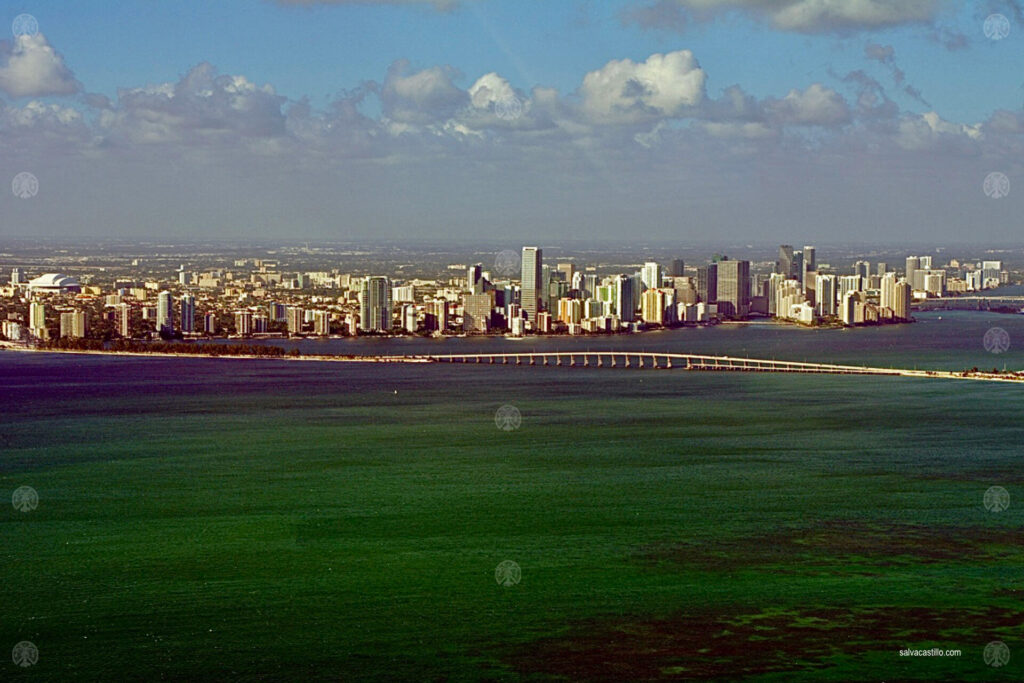
The American Airlines Arena -now Crypto Arena-, home of the Miami Heat basketball team -triple NBA champions-. On the left, the ochre-colored Freedom Tower. On the right, the Adrienne Arsht Performing Arts Center and the Ziff Opera House, a very modern facility in which to see classic shows in Miami.
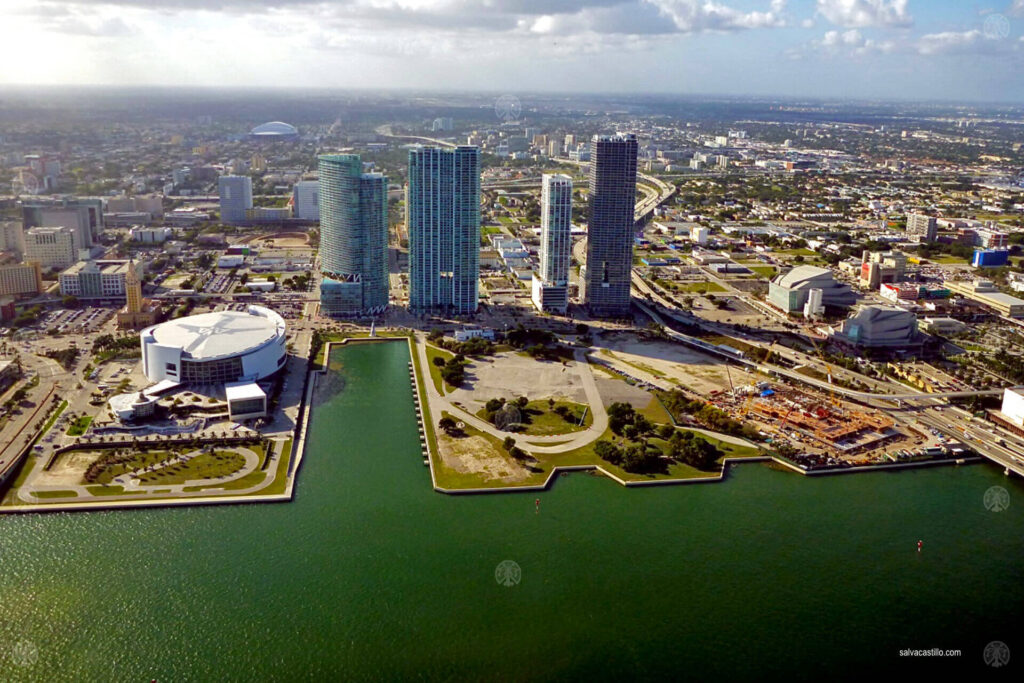
The mouth of the Miami River, which runs through Downtown in the Brickell area.

The Miami Downtown skyline is also a light show at night.
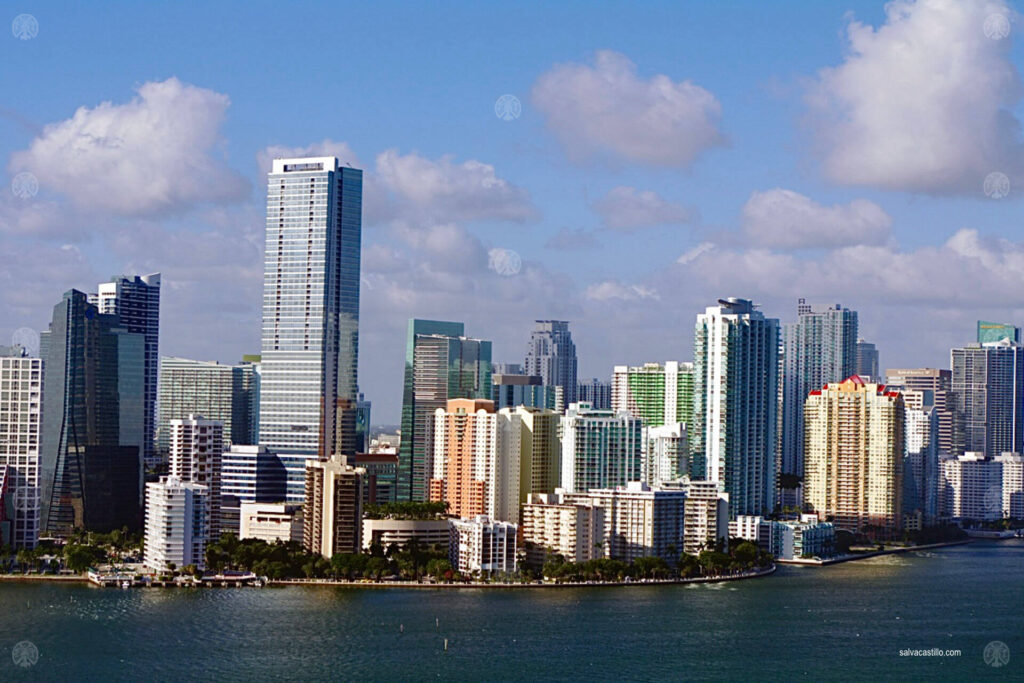
From the sequence of Keys in South Florida there are a couple of them that are close to the city of Miami. In Key Biscayne a famous tennis tournament was held that has had as winners Djokovic, Federer, Agassi, Lendl, Navratilova, Chris Evert, Arantxa Sanchez-Vicario, or Serena Williams.
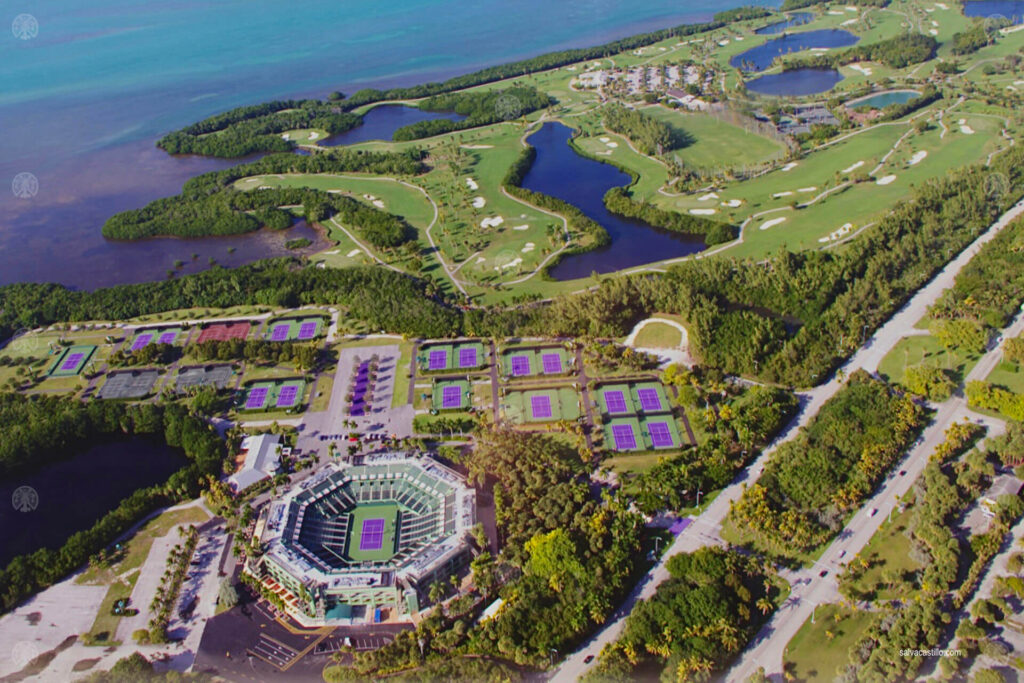
On the other upper key, Virginia Key, is the Miami Seaquarium, an exceptional facility for observing marine life.

A large part of Cayo Vizcaino is occupied by natural parks with free access. I am especially fond of Crandon Park, which is a large white beach with crystal clear waters, on the other side of a golf course. I like this photo because the kite surfers’ kites float in the crystal clear water of Key Biscayne.

Another type of water sport is practiced in Virginia Key: windsurfing. It became the water sport par excellence in Miami in the early 1980s, before technology evolved and made it possible to create new forms of water sports such as kite surfing -or the more recent foil surfing-. On the other side of Virginia Key is the old Miami Aquatic Stadium, where in the crazy eighties water competitions of all kinds were held, including the outboard boat races that made Miami the water sports capital of the world. I respect all generations, but there are things we enjoyed in the 80’s and 90’s that today would not be allowed for the sake of safety and whatnot. Hey, stop busting our balls and let us enjoy life.

I have lived in Miami for over 14 years, having moved here permanently in 2009. Before that, throughout 2006 and 2007, I had visited the city several times for work, and I had fallen in love with it.
If for Europeans in general it is difficult to find architectural appeal in American cities because of the “recentness” of their historical sites, imagine for a guy born and raised in Cordova, where if you dig a hole in the middle of the countryside 3 km away from the current edge of the city chances are you may find the foundations of a 1000 year old house. We Europeans all tend to be disdainful of American cities because “they lack charm”, “papier-mâché” and the famous “not so long ago all this was a waste ground”. It is clear that there is no comparison in that particular aspect.

However, Miami has a semi-sweltering tropical natural environment and a context that makes it unique. It is a city in a third world climate with a first-world social structure, security, services and infrastructure. I kindly wait for you to point me to other cities that meet those requirements.
It may not have the historical significance that other European cities have, but Miami is a very, very, very good place to live. And I have enjoyed it a lot. I wouldn’t change it for anything. Miami 305 4ever 🫶🏻.